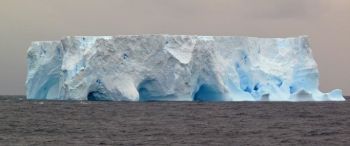
Publisher:
Bonnie King
CONTACT:
Newsroom@Salem-news.com
Advertising:
Adsales@Salem-news.com

~Truth~
~Justice~
~Peace~
TJP
May-29-2014 07:04

 TweetFollow @OregonNews
TweetFollow @OregonNews
Antarctic Ice Sheet Unstable; Causing Rapid Sea Level Rise
Salem-News.comToday, the annual calving of icebergs from Antarctic represents more than half of the annual loss of mass of the Antarctic Ice Sheet.
 The researchers examined two sediment cores from the Scotia Sea between Antarctica and South America that contained “iceberg-rafted debris” that had been scraped off Antarctica by moving ice and deposited via icebergs into the sea. Photo: Michael Weber, University of Cologne |
(CORVALLIS, Ore. ) - A new study has found that the Antarctic Ice Sheet began melting about 5,000 years earlier than previously thought coming out of the last ice age – and that shrinkage of the vast ice sheet accelerated during eight distinct episodes, causing rapid sea level rise.
The international study, funded in part by the National Science Foundation, is particularly important coming on the heels of recent studies that suggest destabilization of part of the West Antarctic Ice Sheet has begun.
Results of this latest study are being published this week in the journal Nature. It was conducted by researchers at University of Cologne, Oregon State University, the Alfred-Wegener-Institute, University of Hawaii at Manoa, University of Lapland, University of New South Wales, and University of Bonn.
The researchers examined two sediment cores from the Scotia Sea between Antarctica and South America that contained “iceberg-rafted debris” that had been scraped off Antarctica by moving ice and deposited via icebergs into the sea. As the icebergs melted, they dropped the minerals into the seafloor sediments, giving scientists a glimpse at the past behavior of the Antarctic Ice Sheet.
Periods of rapid increases in iceberg-rafted debris suggest that more icebergs were being released by the Antarctic Ice Sheet. The researchers discovered increased amounts of debris during eight separate episodes beginning as early as 20,000 years ago, and continuing until 9,000 years ago.
The melting of the Antarctic Ice Sheet wasn’t thought to have started, however, until 14,000 years ago.
“Conventional thinking based on past research is that the Antarctic Ice Sheet has been relatively stable since the last ice age, that it began to melt relatively late during the deglaciation process, and that its decline was slow and steady until it reached its present size,” said lead author Michael Weber, a scientist from the University of Cologne in Germany.
“The sediment record suggests a different pattern – one that is more episodic and suggests that parts of the ice sheet repeatedly became unstable during the last deglaciation,” Weber added.
The research also provides the first solid evidence that the Antarctic Ice Sheet contributed to what is known as meltwater pulse 1A, a period of very rapid sea level rise that began some 14,500 years ago, according to Peter Clark, an Oregon State University paleoclimatologist and co-author on the study. The largest of the eight episodic pulses outlined in the new Nature study coincides with meltwater pulse 1A.
“During that time, the sea level on a global basis rose about 50 feet in just 350 years – or about 20 times faster than sea level rise over the last century,” noted Clark, a professor in Oregon State’s College of Earth, Ocean, and Atmospheric Sciences. “We don’t yet know what triggered these eight episodes or pulses, but it appears that once the melting of the ice sheet began it was amplified by physical processes.”
The researchers suspect that a feedback mechanism may have accelerated the melting, possibly by changing ocean circulation that brought warmer water to the Antarctic subsurface, according to co-author Axel Timmermann, a climate researcher at the University of Hawaii at Manoa.
“This positive feedback is a perfect recipe for rapid sea level rise,” Timmermann said. Some 9,000 years ago, the episodic pulses of melting stopped, the researchers say. “Just as we are unsure of what triggered these eight pulses,” Clark said, “we don’t know why they stopped. Perhaps the sheet ran out of ice that was vulnerable to the physical changes that were taking place. However, our new results suggest that the Antarctic Ice Sheet is more unstable than previously considered.”
Today, the annual calving of icebergs from Antarctic represents more than half of the annual loss of mass of the Antarctic Ice Sheet – an estimated 1,300 to 2,000 gigatons (a gigaton is a billion tons). Some of these giant icebergs are longer than 18 kilometers.
Source: Oregon State University
Articles for May 28, 2014 | Articles for May 29, 2014 | Articles for May 30, 2014


googlec507860f6901db00.html


Quick Links
DINING
Willamette UniversityGoudy Commons Cafe
Dine on the Queen
Willamette Queen Sternwheeler
MUST SEE SALEM
Oregon Capitol ToursCapitol History Gateway
Willamette River Ride
Willamette Queen Sternwheeler
Historic Home Tours:
Deepwood Museum
The Bush House
Gaiety Hollow Garden
AUCTIONS - APPRAISALS
Auction Masters & AppraisalsCONSTRUCTION SERVICES
Roofing and ContractingSheridan, Ore.
ONLINE SHOPPING
Special Occasion DressesAdvertise with Salem-News
Contact:AdSales@Salem-News.com
Terms of Service | Privacy Policy
All comments and messages are approved by people and self promotional links or unacceptable comments are denied.
[Return to Top]
©2025 Salem-News.com. All opinions expressed in this article are those of the author and do not necessarily reflect those of Salem-News.com.